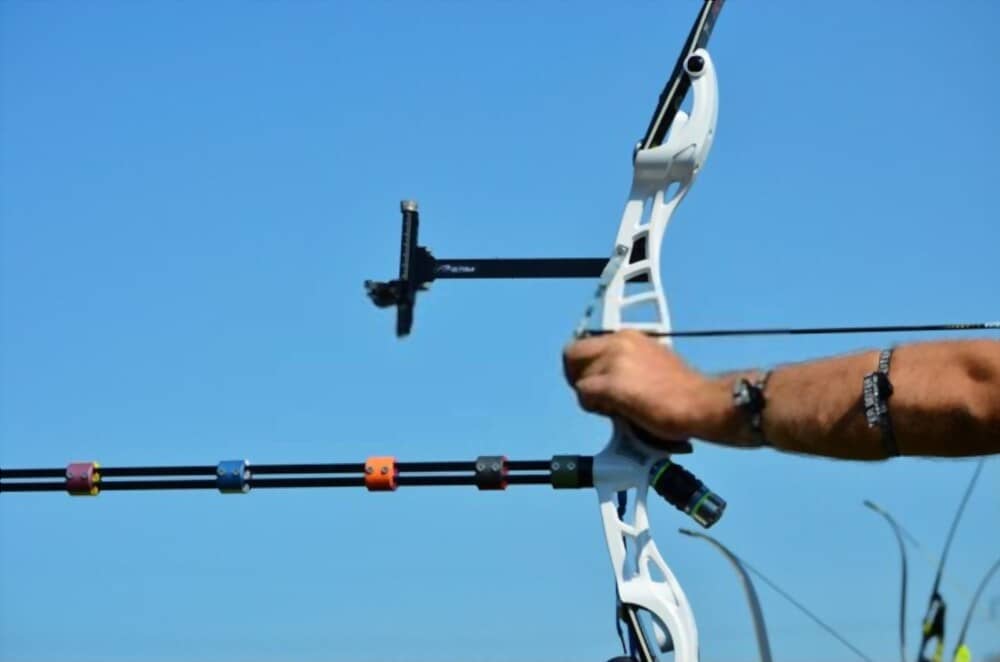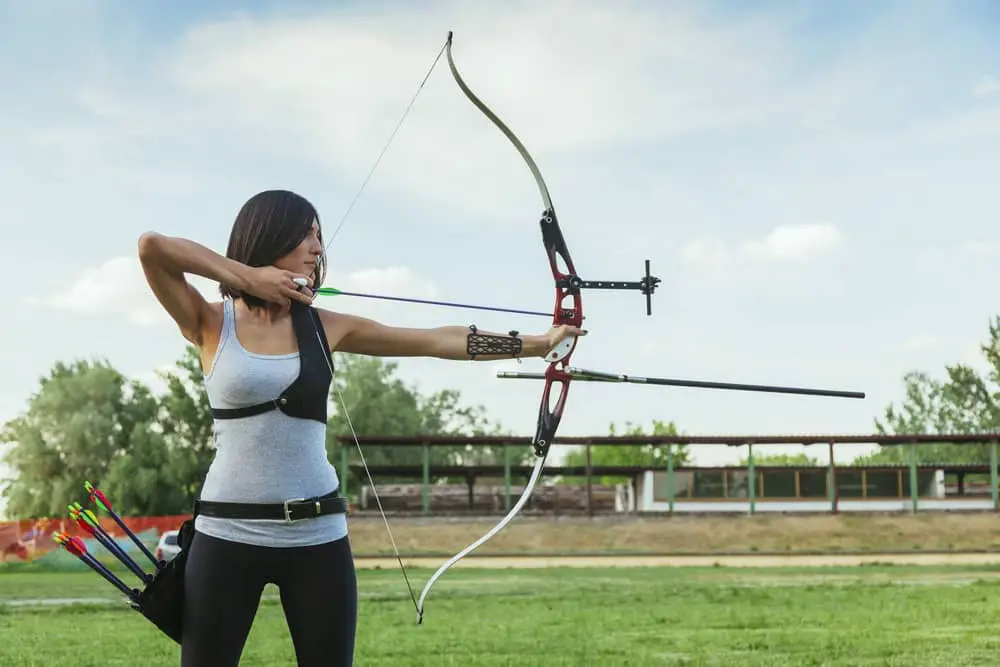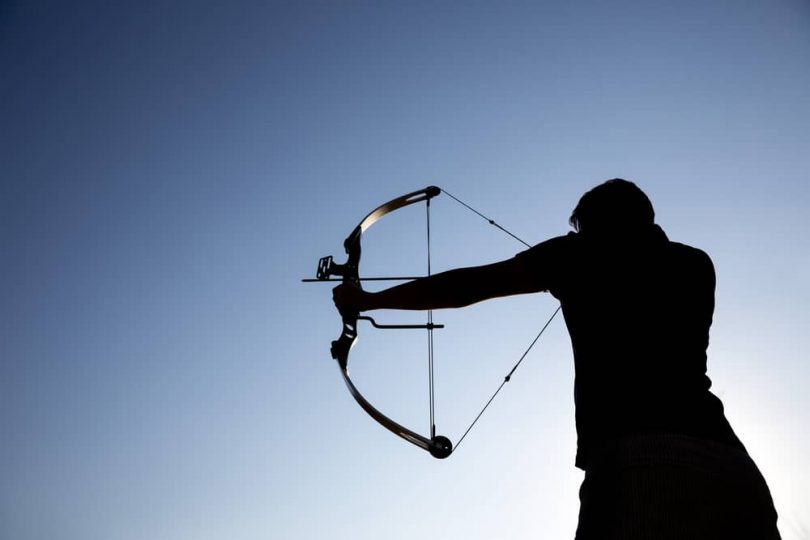The stability of your bow is crucial when you are taking a shot. A steady bow whether the crossbow, the compound bow, or the longbow would improve the odds of hitting the bull’s eye, which is the objective of anyone interested in archery.
Those participating in any type of archery, whether for hunting or target shooting, have to learn the techniques of stabilizing the bow. Bow stabilizers function to steady the bow and make your shot more precise by decreasing the friction induced when you release the bowstring.
So, what does a bow stabilizer do? Before we get there, let’s have a quick look at what they actually are.
bow stabilizer purpose The name says it all – it literally stabilizes your bow by reducing the bow’s movement and vibrations during the shot. It helps absorb shock, balance the bow for better aim, and reduce noise, making it an essential archery accessory for archers of all types and skills.
What is a Bow Stabilizer?
A bow stabilizer has two main tasks – to hold the bow steady and stable, and to reduce hand vibration and shock.
These stabilizers come in different lengths – from a few inches to over a foot, and the stabilizer weight can vary depending on the design and the archer’s preference. Longer stabilizers provide greater stability and dampening effects but are less maneuverable while shorter stabilizers offer more maneuverability but have slightly reduced performance in vibration reduction.
Bow stabilizers often come with features to help enhance their effectiveness. For instance, some have removable weights so the overall weight and balance of the bow can be adjusted according to the archer’s shooting style. Some have dampening materials like rubber or gel inserts to absorb and reduce vibrations generated during the shot.
Overall, you need a bow stabilizer to improve your shooting accuracy and consistency. All types of archers commonly use this popular accessory for target shooting, bowhunting, and other types of archery.
What Does a Bow Stabilizer Do?
A bow stabilizer is far more than just an element that makes the compound bow look awesome. It is a reinforced rod installed on a bow that decreases the bow’s movements while increasing the accuracy of your shot.
Bow stabilizers even handle the intense vibrations produced when the bowstring is released. This elimination of vibration leads to the arrow’s successful launch.
To develop your archery skills to the highest level, you need to have a bow stabilizer. For all-around archery, the stabilizer length should be 10 inches as it is lightweight enough for bowhunting and helps minimize group sizes.
Seasoned bowhunters find a bow stabilizer essential if they use an ultra-lightweight bow, shoot more than 40 yards at a mark, or if there is a severe crosswind.
How Does a Bow Stabilizer Work?
When you release an arrow, several forces are exerted on the bow, including the force applied by the string, the movement of the limbs, and the release of energy stored in the bow. These forces can cause the bow to torque or twist, leading to instability and affecting accuracy.
This is where the bow stabilizer purpose is served. It counteracts these forces by adding mass to the bow and altering its balance point. The weight at the front end of the stabilizer provides a counterbalance to the rear weight distribution of the bow. This makes it more balanced and helps reduce the tendency to torque or twist upon release.
What’s more, the weight of the stabilizer absorbs energy and dampens vibrations generated during the shot. As the arrow is released and the bow limbs spring forward, the stabilizer absorbs some of that energy and acts as a shock absorber.
A stabilizer can even help increase the moment of inertia of the bow, which makes it less sensitive to slight movements or errors in shooting form. This increased stability allows archers to hold their aim more steadily, especially for longer periods, improving their overall accuracy.
Bow Stabilizer Pros

1. Increasing the stability of the bow
Only the bow stabilizer can provide your bow with forwarding weight. That should align your hands with the bow and reduce any vibrations that occur as you fire.
You will have to consider boosting the weight of the stabilizer and the length for optimal stabilization. The more severe they are, the higher the likelihood of staying on the mark.
2. Taking more accurate shots
More balance as you take your shots improves your odds of making more precise shots. This benefit is most noticeable when you take a shot from a distance.
When you fire at long-distance targets, even the slightest movement will carry the arrow away from the target. The use of a stabilizer limits such small motions.
When you take a long shot next time, try using a stabilizer to improve your accuracy and consistency rate.
If you take the stabilizer away from your bow, it will often be impossible to have a precise shot, and you will be imbalanced. Besides, friction and hand impact that occurs when you take a shot can impact it too.
3. Absorbing bow vibrations
When you fire the arrow at your mark, vibrations also occur in your hands. The result will be tension whenever you fire your bow.
Energy transfers from the area of the arm guard are the energy that causes vibrations. This energy is absorbed by a bow stabilizer as you pull a bow backward before you take a shot.
This vibration elimination would save your palms from bruises. Most significantly, the noise is also minimized, which is very important if you are hunting.
4. Reducing noise
Every bowhunter understands that silence is pure gold while hunting. Deer have a sensitive sense of hearing in general, so you ought to do your best to minimize noise.
When a deer hears something strange, it will begin to move rapidly and will have traveled 2-3 feet before your arrow even reaches it.
It’s quite difficult to strike a moving target, as you might already know, so a stabilizer on a bow is such a helpful tool to decrease bow noise and improve your chances of getting a clean shot.
5. Managing bow rotation
By this, we take into consideration the “moment of inertia.” The basic theory is that you would need to use a minimal weight on a broad rod to minimize the moment of inertia.
Notably, large objects such as bow risers that are long and narrow structures will have limited inertia moments where only small forces will lead to axis rotations.
Stabilizers compensate for any minor forces which might trigger movement, enabling you to get an effective shot.
Bow Stabilizer Cons

1. Stabilizers add additional weight
If you’re not able to carry the extra load, a bow stabilizer might not be your best option. Attaching a bow stabilizer to a bow will raise the bow’s weight from 75 g to 350 g.
The extra weight will make the hunting session challenging, particularly when you’ve had to keep the strings back for a long time searching for the kill shot.
The secret is to exercise and practice being relaxed with your bow in all situations.
2. A long stabilizer could make you visible
Bow stabilizers could be up to 32 inches in length and could reveal your hiding spots. Even though these stabilizers help decrease noise and vibration, their length will reveal your hiding places if not well managed.
Use one that is 7 inches or 12 inches rather than using a 32-inch stabilizer for hunting. You will still have the accuracy advantage without the inconvenient length.
3. Start losing the feel of conventional archery
Traditional Archery refers to the ability to learn how to make an accurate shot without using all the latest accessories. By applying a stabilizer to their bow, the feeling of raw talent that is the core of Conventional Archery will make certain archers feel like cheating.
The use of bow stabilizers has made numerous archers dependent on them through time.
4. The false impression of an easy fix
A bow stabilizer would not make you more successful than the skill sets you have if you are a beginner. Also, it won’t improve your performance rate but only make you fine-tune the talents you have.
No archery attachment in the world makes you successful if your archery skill is terrible. It is important to note that bow stabilizers are just pieces of equipment.
Conclusion
Accuracy is always increased by a bow stabilizer. You can use a stabilizer to increase your accuracy whether you hunt from a treestand or a plain, or in a case where weight is not a concern.
But a stabilizer can be called an elective in extremely mobile hunting conditions where weight can make the difference between participating or not.
Now that you know what does a bow stabilizer do, we hope you’ll be able to
FAQs
1. What is the perfect stabilizer length for target archery?
Ans. The length of the stabilizer that you will need for the target archery mainly depends on the range between you and the target. More length also allows you more accuracy, so a 30-inch bow stabilizer is ideal for this task.
2. What is the best length of bow stabilizer for hunting?
Ans. If you are going on hunting, you may want to get a smaller bow stabilizer, so you have to be able to move across the forest without hanging up on leaves, tree branches, etc. Because most shots are done below 50 yards, your precision should be high enough so that the 30-inch stabilizer is not necessary.
3. Are bow stabilizers permitted at barebow archery?
Ans. Barebow archery is an archery variant that doesn’t have sights, so there are no bow pointing and no clickers to assist your shots. It is really strict, including the kind of arrow resting you are permitted to use. Some associations only allow the use of a stabilizer with very unique and restricted lengths and weights. Other organizations do not approve of any type of bow stabilizers.
4. Is a longer bow stabilizer better?
Ans. The longer the bow stabilizer is, the lower the weight needs to be to balance the bow. More weight is required for shorter stabilizers to accomplish the same. This implies that a smaller but heavier stabilizer can be used when space is a problem.








Leave a Comment